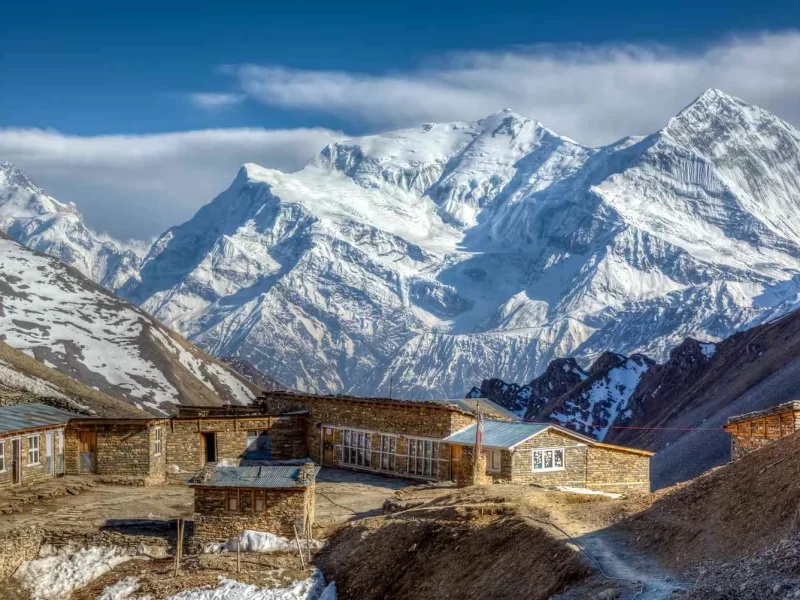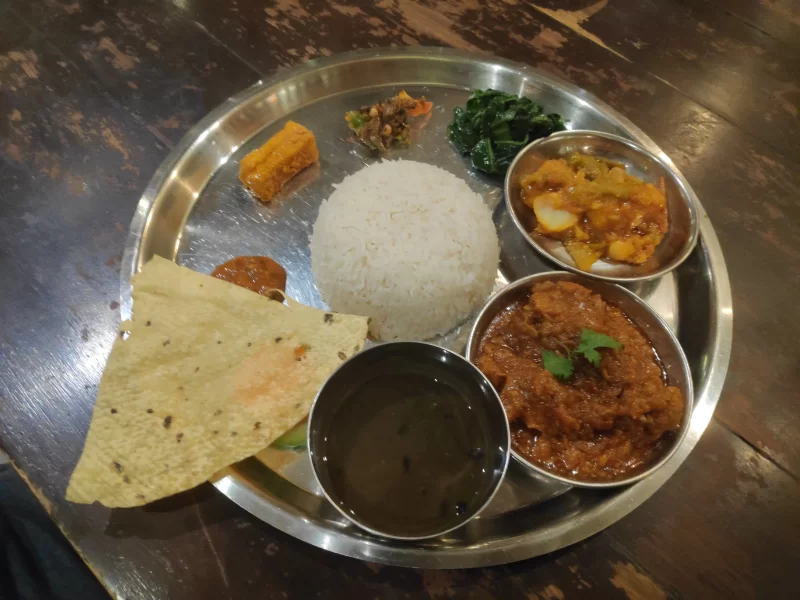Understanding Budget Trekking in Nepal:
At Shangrila Adventure, we understand the desire to embark on an unforgettable trekking journey without breaking the bank. Budget trekking in Nepal is all about finding ways to enjoy the beauty of the Himalayas while being mindful of costs and seeking affordable alternatives. We believe that everyone should have access to the wonders of trekking, regardless of their budget. Our commitment is to provide you with budget-friendly options while ensuring your safety, comfort, and the best possible experience.
Best Time for Budget Trekking in Nepal:
Timing is everything when it comes to saving money on your trekking adventure. The off-peak seasons offer significant advantages in terms of reduced costs and a quieter trekking experience. During these periods, accommodations are more readily available, and you can often secure better deals. Consider trekking during the shoulder seasons of spring (March to May) or autumn (September to November) when the weather is favorable, and the trails are less crowded.
During spring, the landscape comes alive with blooming rhododendrons, adding vibrant colors to your trek. The temperatures are generally mild, and the skies are clear, providing excellent views of the surrounding mountains. In autumn, you’ll witness breathtaking landscapes adorned with golden hues as the forests change their colors. The weather is stable, and the visibility is excellent, making it ideal for capturing stunning photographs.
Choosing Budget-Friendly Trekking Routes:
Nepal offers a wide range of trekking routes that provide incredible natural beauty without putting a strain on your budget. Here are a few more budget-friendly trekking options that will give you an unforgettable experience without compromising on scenic views:
1. Ghorepani Poon Hill Trek: The Ghorepani Poon Hill Trek is popular and accessible in the Annapurna region that offers breathtaking views of the Annapurna and Dhaulagiri mountain ranges. This short and moderately challenging trek takes you through charming villages, lush rhododendron forests, and terraced fields. The highlight of the trek is the iconic sunrise view from Poon Hill, where the mountains glow in golden hues, creating a magical experience.

2. Mardi Himal Trek: If you’re looking for a quieter and less crowded trek, the Mardi Himal Trek is a hidden gem in the Annapurna region. This relatively new trek takes you through lush forests, and picturesque villages, and offers stunning panoramic views of the Annapurna and Machhapuchhre (Fishtail) mountains. The trail is less frequented by trekkers, providing a serene and peaceful experience. The Mardi Himal Trek can be completed in a shorter duration, making it a budget-friendly option.
3. Tamang Heritage Trail: The Tamang Heritage Trail is a culturally rich trek that explores the Tamang people’s traditions and lifestyle in the Langtang region. This off-the-beaten-path trek takes you through scenic landscapes, terraced fields, and traditional Tamang villages. You’ll have the opportunity to learn about the Tamang community’s unique culture, visit ancient monasteries, and enjoy panoramic mountain views.
These alternative trekking routes provide unique experiences, stunning landscapes, and cultural encounters, all while being more affordable compared to popular routes. As always, it’s important to research and plans your trek, considering factors such as duration, difficulty level, and permit requirements.
Packing Smart, Essential Gear on a Budget:
Packing for your trek doesn’t have to be an expensive affair. While having the right gear is crucial for a comfortable trekking experience, there are ways to keep costs down without compromising on quality. Here are some tips for packing smart on a budget:
- Rent or borrow gear: If you don’t want to invest in expensive trekking gear, consider renting or borrowing items from friends or fellow trekkers. Trekking poles, sleeping bags, down jackets, and other equipment can often be rented from trekking agencies or gear rental shops in Kathmandu or Pokhara at a fraction of the cost.
- Shop around for affordable gear: If you do decide to purchase gear, compare prices at different stores in Kathmandu or Pokhara. You’ll find a wide range of options catering to different budgets. Look for sales, discounts, or second-hand gear in good condition to save money.
- Pack light and essentials: Avoid overpacking by focusing on the essentials. Carry lightweight, moisture-wicking clothing suitable for the trekking season, a good pair of trekking boots, a comfortable backpack, a headlamp, a first aid kit, and toiletries. Remember that you can always purchase snacks and other necessary items at teahouses along the trail.
By being strategic with your packing choices and opting for budget-friendly alternatives, you can keep your expenses in check without compromising on comfort or safety during your trek.
Budget Accommodation Options:

Teahouse trekking is a popular choice for budget-conscious trekkers in Nepal. Teahouses are simple lodges that provide basic accommodations and meals along the trekking routes. They offer a unique opportunity to connect with fellow trekkers and immerse yourself in the local culture. Shangrila Adventure has established partnerships with reputable teahouses, ensuring comfortable stays at affordable prices for our clients. These teahouses typically offer private or shared rooms with twin beds, clean bedding, and blankets to keep you warm during chilly nights. While the facilities may be basic, they provide a cozy and authentic experience that aligns perfectly with the spirit of trekking in Nepal.
Cost-Saving Food Choices:

Savoring delicious meals while trekking in Nepal doesn’t have to be expensive. Teahouses along the trails offer a range of reasonably priced food options. Opt for local Nepali dishes like dal bhat (rice and lentil soup) or momo (dumplings) that provide a filling and authentic dining experience without breaking the bank. These meals often come with unlimited refills, ensuring you have the energy needed for your trek. You’ll also find a variety of international dishes and snacks on the menu, although they may be slightly pricier. It’s worth noting that prices tend to increase as you ascend higher into the mountains due to the logistics involved in transporting supplies. However, rest assured that the food served in teahouses is freshly prepared and provides a welcome respite after a day of trekking.
To further save on food costs, consider carrying your refillable water bottle and using water purification tablets or filters to treat water from natural sources along the trail. This will help you avoid purchasing bottled water, not only saving money but also reducing plastic waste and contributing to a more sustainable trekking experience.
Transportation and Permit Tips:
To keep transportation costs down, consider utilizing public buses or shared jeeps to reach the starting points of your treks. These options are more budget-friendly compared to private transfers. Public buses are a common mode of transportation in Nepal, offering affordable fares and a chance to mingle with locals. Shared jeeps, though slightly more expensive than buses, provide a quicker and more comfortable journey, especially on rough mountain roads.
When it comes to permits, be sure to research the required permits for your chosen trek in advance. The most common permits are the Trekkers’ Information Management System (TIMS) card and the Annapurna Conservation Area Permit (ACAP) or Sagarmatha National Park Permit, depending on your trek. Acquiring permits directly from authorized government offices or through reputable trekking agencies can help you avoid unnecessary fees or scams. Shangrila Adventure can assist you in obtaining the necessary permits, ensuring a hassle-free process and accurate information.
Hiring a Guide and Porter, Balancing Costs and Support:
Hiring a guide or porter can enhance your trekking experience, especially if you’re new to the region or prefer additional assistance. While there is an added cost, their expertise, knowledge of the trails, and support can be invaluable, allowing you to focus on enjoying the journey. Guides are particularly beneficial if you want to learn about the local culture, flora, fauna, and history of the areas you’ll be trekking through. They can provide valuable insights, assist with navigation, and ensure your safety throughout the trek.
Porters, on the other hand, can shoulder the burden of carrying your heavy backpack, allowing you to trek more comfortably and enjoy the scenery. By hiring a porter, you can lighten your load and reduce the physical strain, especially during challenging sections of the trek. This way, you can focus on immersing yourself in the beauty of the Himalayas without worrying about the weight on your back.
At Shangrila Adventure, we offer flexible options for guide and porter services, ensuring competitive pricing while prioritizing your safety and convenience. Our guides are experienced and knowledgeable about the trekking routes, and our porters are reliable and well-trained to handle your belongings with care. Hiring a guide or porter can not only enhance your trekking experience but also provide economic opportunities for the local communities.
Money-Saving Tips and Strategies:
Every penny saved counts, especially when you’re on a budget. Here are some practical tips to help you manage your expenses effectively:
- Plan and budget your trek in advance, considering all costs such as permits, accommodations, transportation, meals, and guide or porter services. Having a clear idea of your expected expenses will help you make informed decisions and avoid overspending.
- Share the cost of permits, transportation, and guide services if you’re trekking with a group. Splitting expenses among fellow trekkers can significantly reduce individual costs and make the journey more affordable for everyone.
- Carry essential snacks and drinks from local markets before starting your trek. These provisions can come in handy during long stretches between teahouses or when you want to supplement your meals without spending extra.
- Consider opting for shorter treks or less popular routes. These routes often have lower permit fees, fewer crowds, and more affordable accommodations, allowing you to have a memorable trekking experience without straining your budget.
- Be mindful of your energy consumption during your trek. Minimize the use of unnecessary items that require charging, such as electronics or power banks, as teahouses may charge extra for electricity usage.
Conclusion:
Embarking on a budget trek in Nepal allows you to experience the magic of the Himalayas without straining your finances. With careful planning, informed choices, and the right partner like Shangrila Adventure, you can create memories that will last a lifetime. We are dedicated to making trekking accessible and affordable for all, without compromising on safety, quality, or the awe-inspiring experiences that Nepal has to offer.

Comment (0)